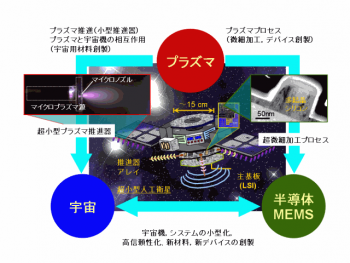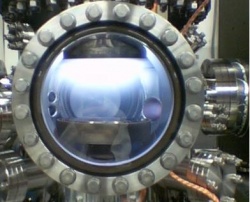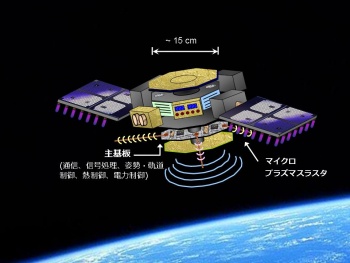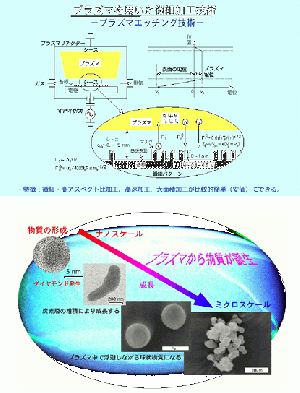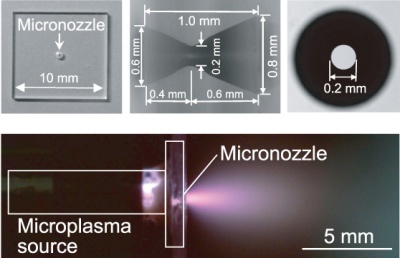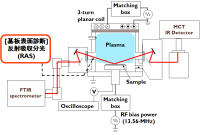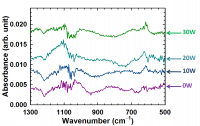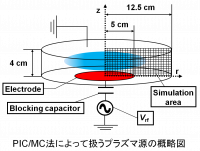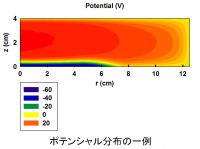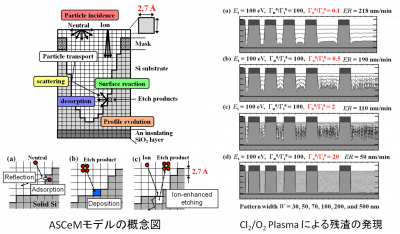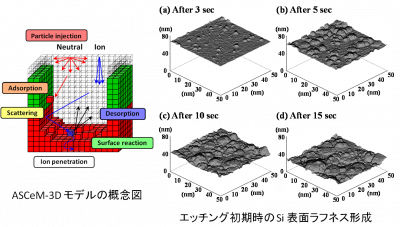京大推進研
We at the Propulsion Engineering Laboratory study the fundamentals and applications of plasma (ionized gas), which is an important medium in spacecraft propulsion. We focus on not only its dynamic characteristics, but also the reactions of the atoms, molecules, electrons, and ions which make up the plasma, and their interactions with solid surface.
Current research topics
- Physics and chemistry of reactive gases and plasmas and their applications
- Gas- and plasma-surface interactions and their applications
- Advanced plasma processing technology (etching, deposition, etc.)
- Advanced plasma and ion sources
- Dynamics of charged particle beams
- Plasma and ion thrusters
- Micro- and nano-technology
among other emerging topics. In pursuing these topics, we employ experiments along with numerical simulations. We also tackle the latest problems in state-of-the-art engineering, not necessarily limited to aeronautics or astronautics.
Overview
Next-generation small-scale, high-performance satellites: the "Silicon Nanosatellites"
In the recent astronautics field, very small-scale "nanosatellites" has been proposed, whose mass is less than 10 kg, or even 1 kg. The advantages of such satellites can be summarized as follows:
- Quick manufacturing due to its simple structure.
- Capable of launching multiple satellites in one rocket mission, or "piggybacking" on a larger mission as a secondary payload. This results in low launch costs.
- Multiple satellites working together to achieve high mission reliability
Of these, no. 3 may allow for entirely new kinds of missions. For example, if we were to have a team of satellites working together as modules, we can change the structure of the system by adding another satellite. Moreover, even if one of the satellites were to malfunction, we could easily fix the problem by launching a new satellite.
As we have seen, the advantages of nanosatellites are diverse. However, in satellites lighter than 1 kg, the requirements imposed on mass, volume, and power consumption is very severe. A simple scaling-down of the conventional satellite systems may not work, calling for an entirely new set of technology. Thrusters (or actuators for the satellite to propel itself or change its attitude/orbit) is not an exception. A new space propulsion system that does not limit itself to the fields of chemical or nonchemical propulsion is required.
At our lab, we have proposed a new type of spacecraft propulsion system employing surface wave excitation plasma, which could potentially be used on next-generation nanosatellites.
Advanced plasma processing technology for material manufacturing and future electron devices fabrication
The rapid advancement of information technology today is fueled by the rapid scaling-down of devices manufactured with ultra large-scale integration (ULSI) processes. In ULSI device fabrication (microfabrication), advanced plasma processes play a major role.
At our lab, we are interested in microfabrication technologies to fabricate high-k (high dielectric constant) gate dielectrics, gate metal electrode materials, etc. at nanometer-scale precision, along with low-k thin film manufacturing which would be indispensable in ultra-fast processors; all of which are very important topics for future semiconductor devices.
In order to achieve our goal, it is important to clarify the reaction mechanisms on MEMS/ULSI device surfaces/interfaces during plasma process. For example, it is known that the ions and electrons in plasma may cause surface interactions which would degrade the performance and reliability of ULSI devices. The same problem exists on surfaces of satellites traveling through the plasma in outer space. That is why we are interested in clarifying the surface/interface reaction mechanisms in nano-scale. We pursue these topics using the latest optical and electrical surface/interface analysis techniques and simulation.
Additionally, reactive plasma is used for semiconductor microfabrication. These kinds of plasmas not only can fabricate existing bulk materials, but could also be used to create an entirely new type of material. Just like our planet Earth was created in the plasma of space, we can create a new material in plasma, something no one has ever seen before.
Individual topics
(To be translated.)
Development of a new type of thruster for nanosatellites
We are working to realize a microwave-excited electrothermal microplasma thruster, consisting of a microplasma source and a micronozzle. We have developed a microplasma thruster using a semiconductor high-frequency device for mobile communication base stations as the microwave source.
The microplasma source is of cylindrical form. The dielectric container has an internal diameter of 2 mm, and a length of 10 mm. The container is covered coaxially by a metal. In this container, the propellant gas is introduced with a pressure of about 10 kPa. Microwave is supplied through a coaxial cable, generating a plasma. The hot, high-temperature plasma expands through a nozzle at the end of the device and is aerodynamically accelerated, thereby providing thrust.
プラズマエッチング中の材料の表面診断
プラズマによる材料加工(プラズマエッチング)においては、反応が進展する過程やメカニズムを明らかにすることが重要になります。FT-IR (フーリエ変換赤外吸収分光法) により、反射光の強度を測定し、基板の表面にどのような粒子が存在するかを明らかにします。
図に示しているのは吸光度 (エッチング前の基板を測定した結果をエッチング後の測定結果で割って対数をとったもの) です。ピークが得られた波数 (wavenumber) から存在する粒子を同定することができます。
粒子モデルを用いたプラズマ気相の数値解析
2次元の粒子モデル(PIC/MC: particle-in-cell/Monte Carlo)を用いて容量結合型高周波プラズマの数値解析を行っています。容量結合型のプラズマ源は、大口径のウェハを均一に加工することができる利点を有しています。本研究では、プラズマ密度・温度・ポテンシャル分布のほか、基板へ入射するイオンのエネルギー・角度・フラックス等を算出しています。右図は、本研究で取り扱っているプラズマ源の概略図と、ポテンシャル分布の計算結果を示しています。電極付近にきわめてポテンシャルドロップが大きい領域(シース)の存在が見てとれます。
Si エッチングのモデリング・シミュレーション
原子スケールによるプラズマ・Si 表面相互反応の理解のため、当研究室では独自に原子スケールセルモデル(Atomic-Scale Cellular Model:ASCeM)を開発しています。本モデルでは、被エッチング表面を、基板 Si 原子1個を中央に含む矩形の微小セルに分割するとともに、パターン内(Vacuum)も同じ大きさの矩形セルに分割して、表面/界面移動を取り扱います。粒子輸送、表面反応過程にはモンテカルロ法を用い、イオンの散乱や内部への侵入はでは、入射イオンと基板原子との間の二体ポテンシャルにもとづき、入射イオンの基板原子による古典的な弾性衝突過程を連続的に計算し、表面反射や内部への侵入を表現しています。
これまでにASCeMを使い、Cl2/O2 混合プラズマによる Si エッチングにおける残渣形状(剣山状の形状)発現メカニズム解明に取り組んできました。右図は、粒子輸送における幾何学的シャドーイング効果により表面の粗さが発達する様子を示しています。残渣形状の発現にはパターン形状と連動した組成の違い(凸部にはO原子が多く凹部には少ない)と、それに伴うエッチング/スパッタリングレートの差が関与していることを明らかにし、そのメカニズムを解明しました。
3次元原子スケールセルモデル (ASCeM-3D)
さらにこれまでの 2次元モデルを改良して、奥行き方向の形状解析を可能とする 3次元原子スケールセルモデル(Three-Dimensional Atomic-Scale Cellular Model:ASCeM-3D)を新たに開発しています。ASCeM-3D はセル・リムーバル法を使った当研究室独自のモデルであり、従来のシミュレーターでは再現しにくい残渣形状や nm スケールの微小な表面ラフネスの形成メカニズムを詳細に解析することが可能です。
大規模スケール分子動力学 (MD) 法
分子動力学(Molecular Dynamics)法を駆使し、Cl2/O2 混合プラズマによる Si エッチングにおける表面反応を追跡しています。これまでの研究により、エッチング時の微小な表面ラフネス形成の形成メカニズムを明らかにしました。このラフネスは、さらに大きなスケール(ナノ~マイクロオーダー)のラフネス形成を誘発すると考えられ、今後のデバイス開発においては、こうした微小な表面ラフネスの正確な制御が強く要求されます。
